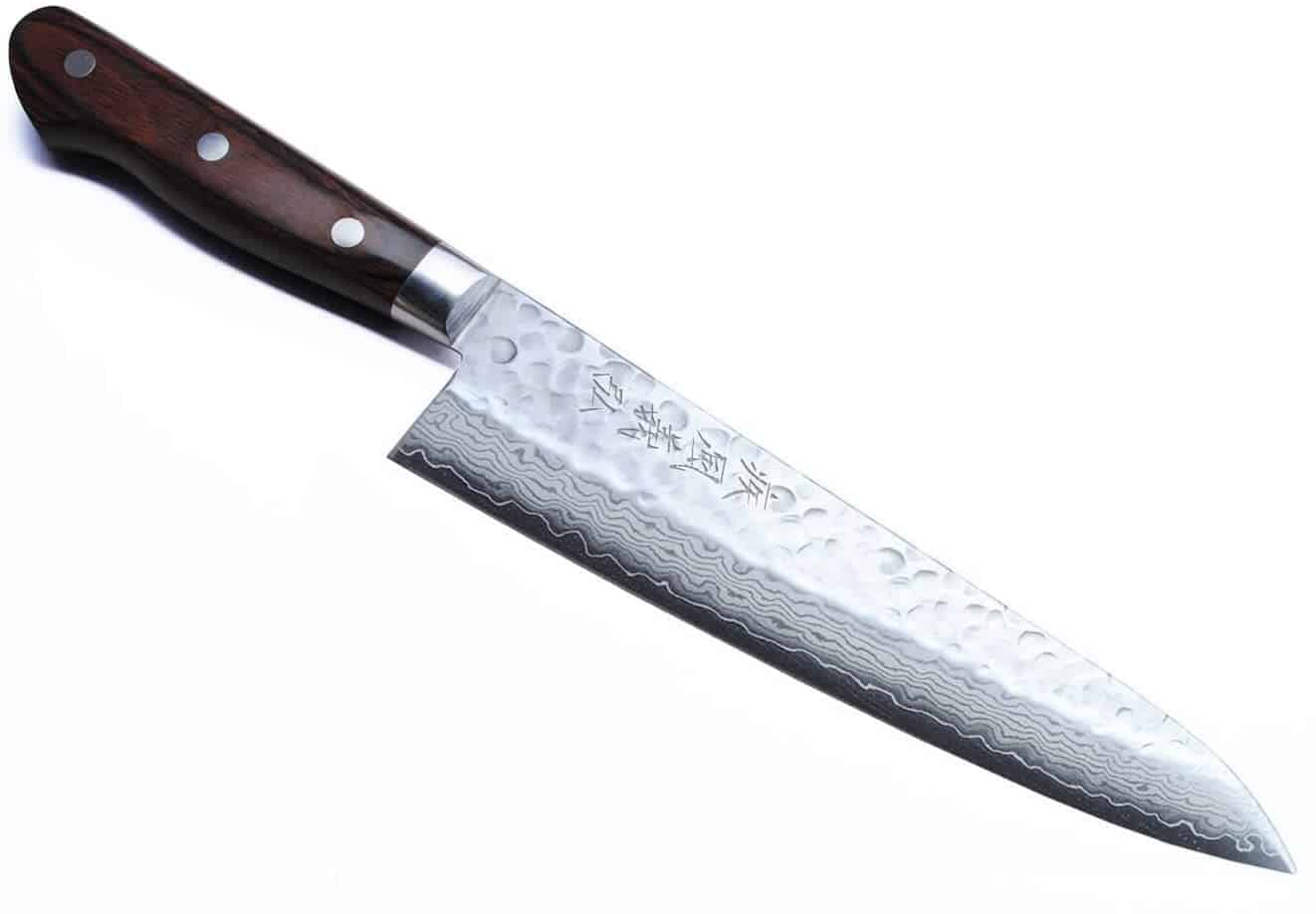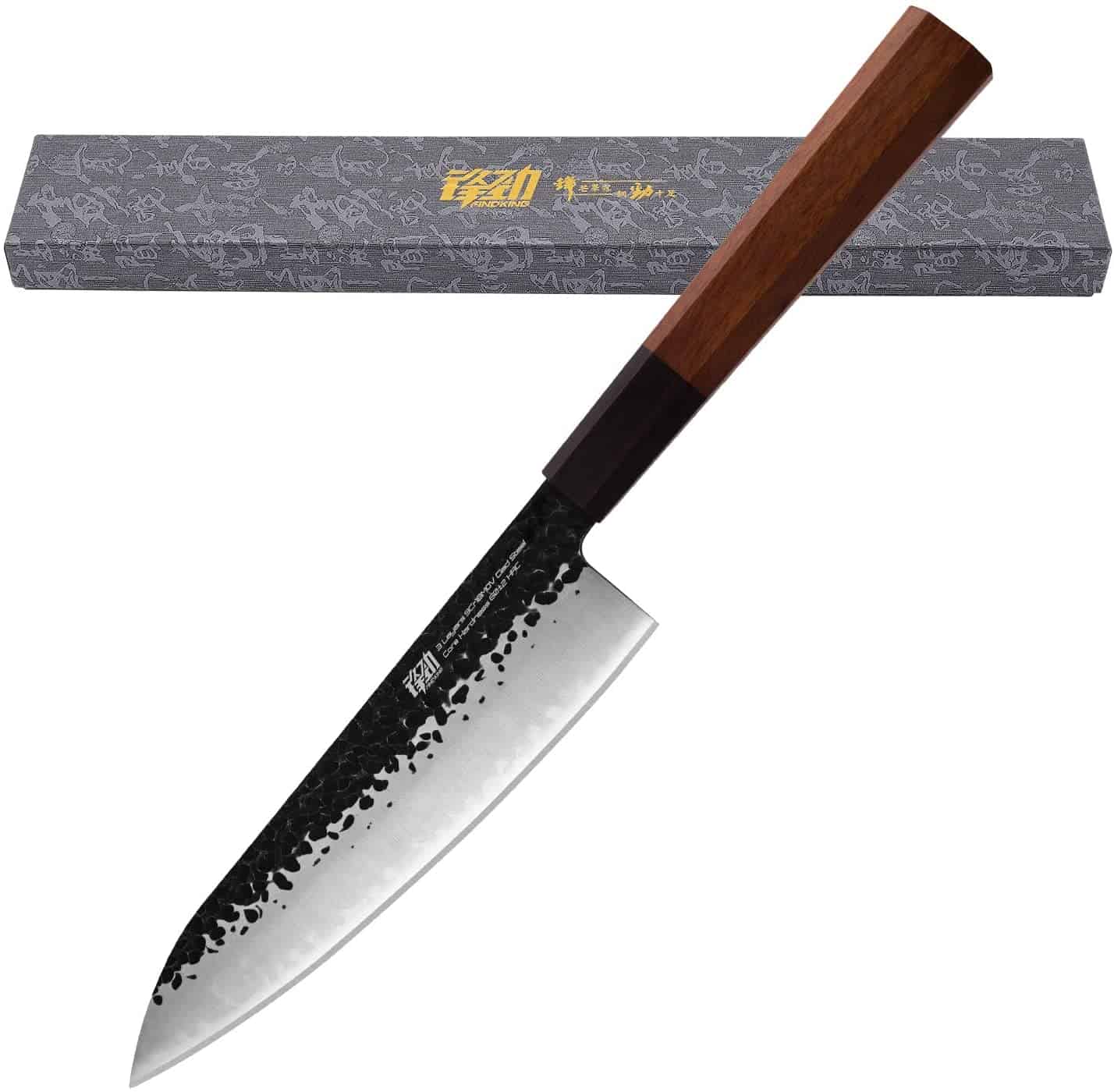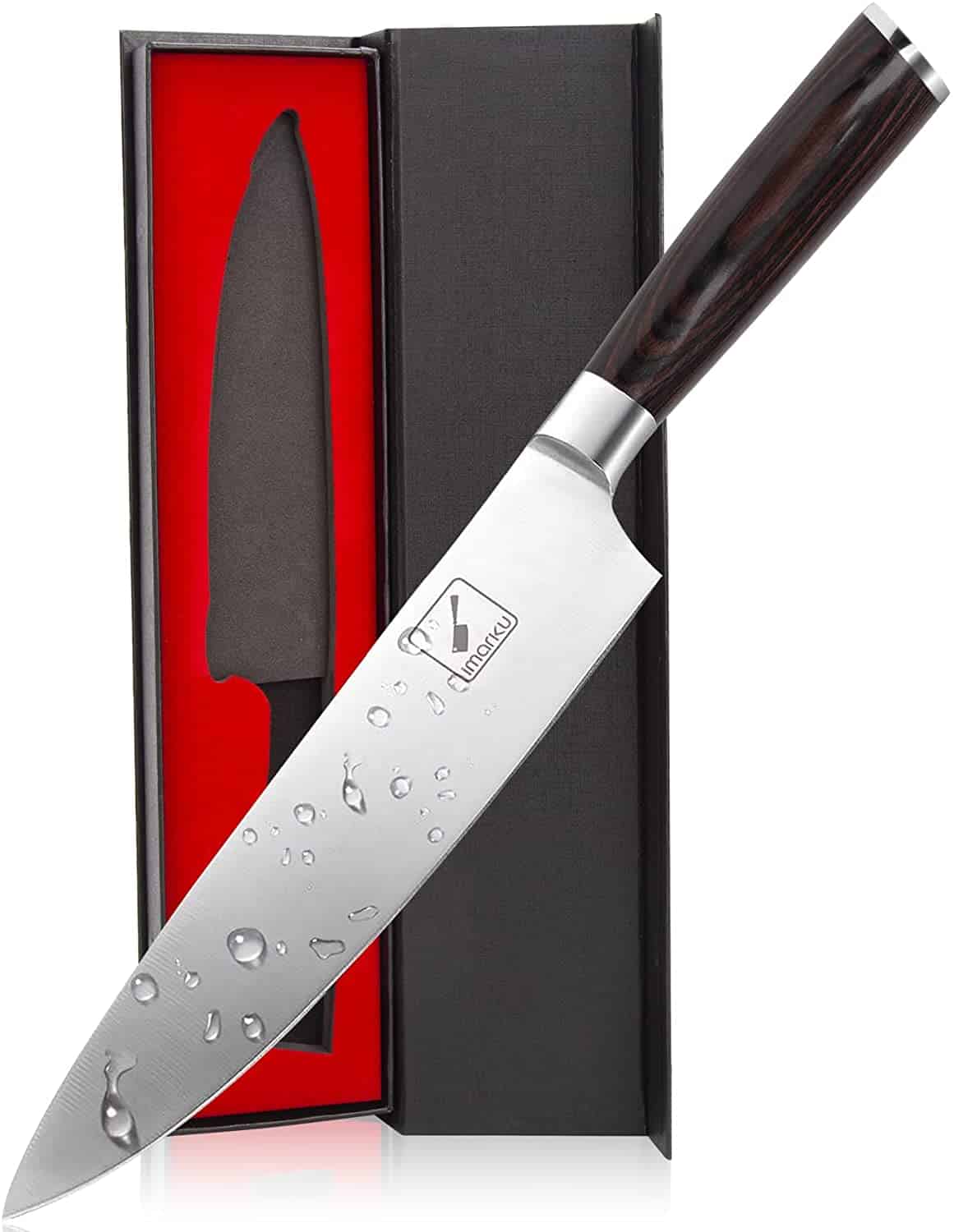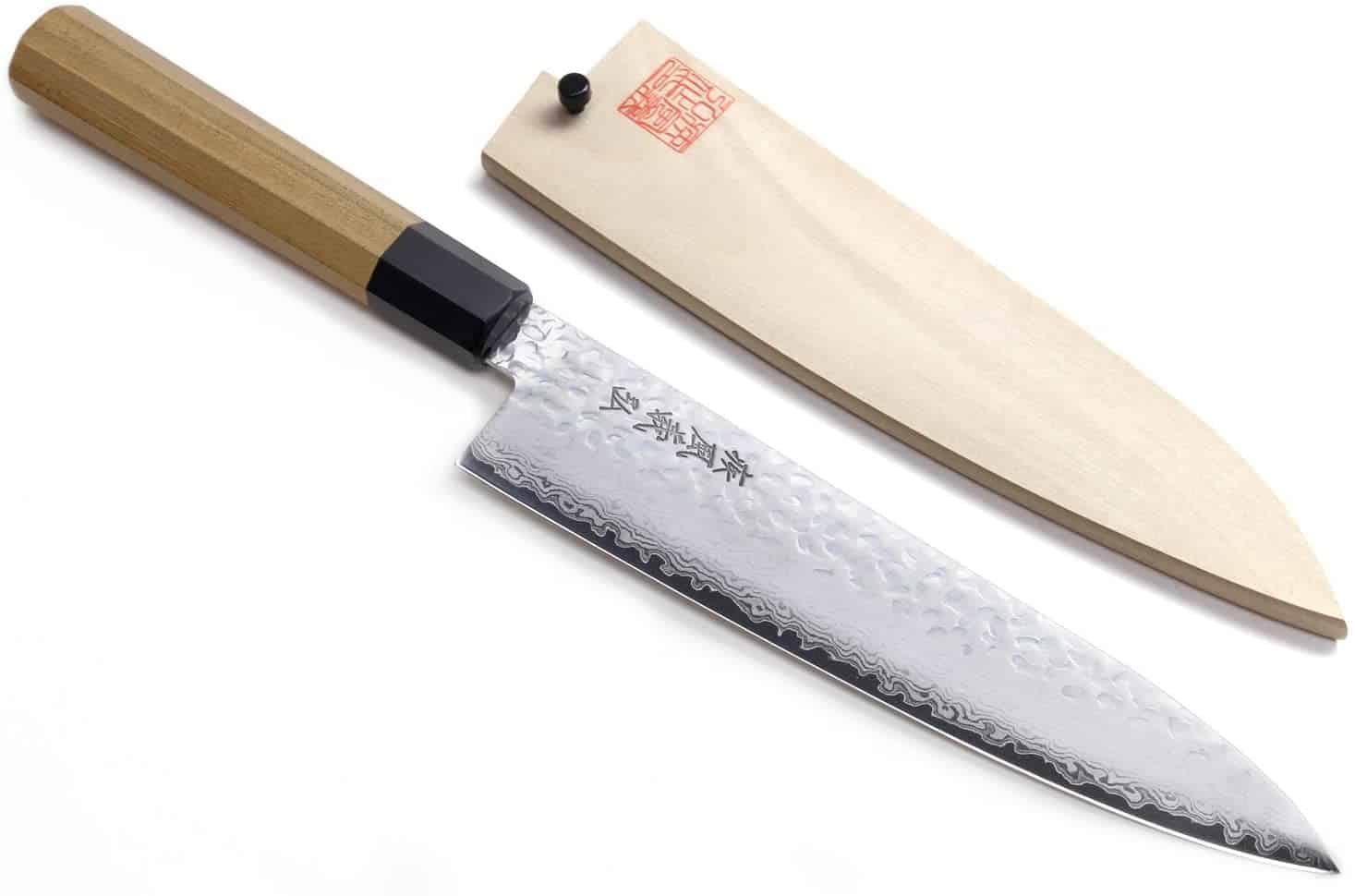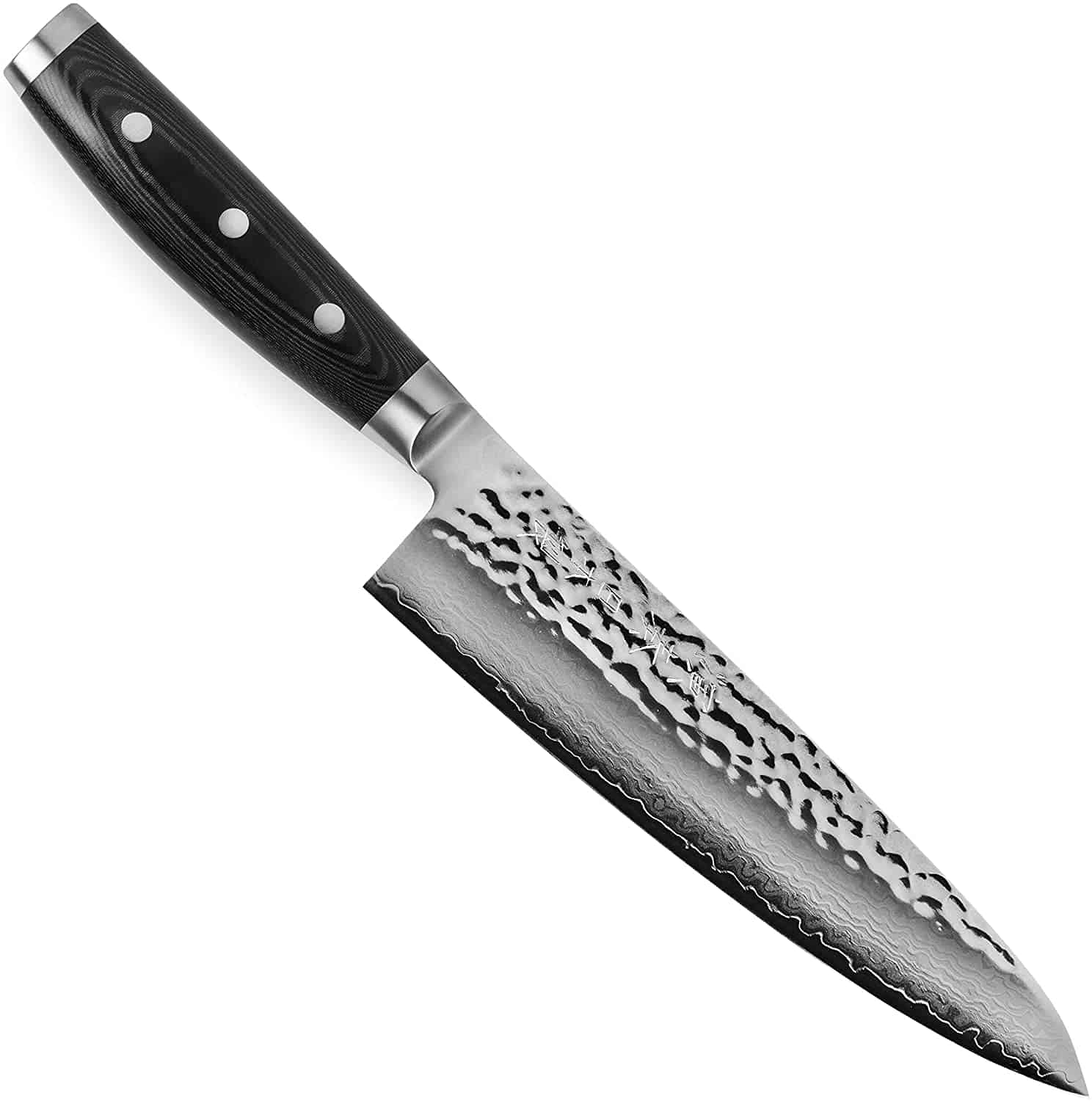6 best gyuto chef’s knives for your Japanese knife collection reviewed
Any kitchen should have one good Japanese gyuto knife. It’s the equivalent of the Western chef’s knife.
This Yoshihiro VG10 16 Layer Hammered Damascus Gyuto is the most versatile gyuto knife from one of the best Japanese knife makers. It can hold an edge better than most knife styles because it’s thicker and heavier with a robust steel construction.
When cooking Japanese food, the gyuto knife is a must-have, and in this guide, I’ll talk about what to look for and which brands you should consider.
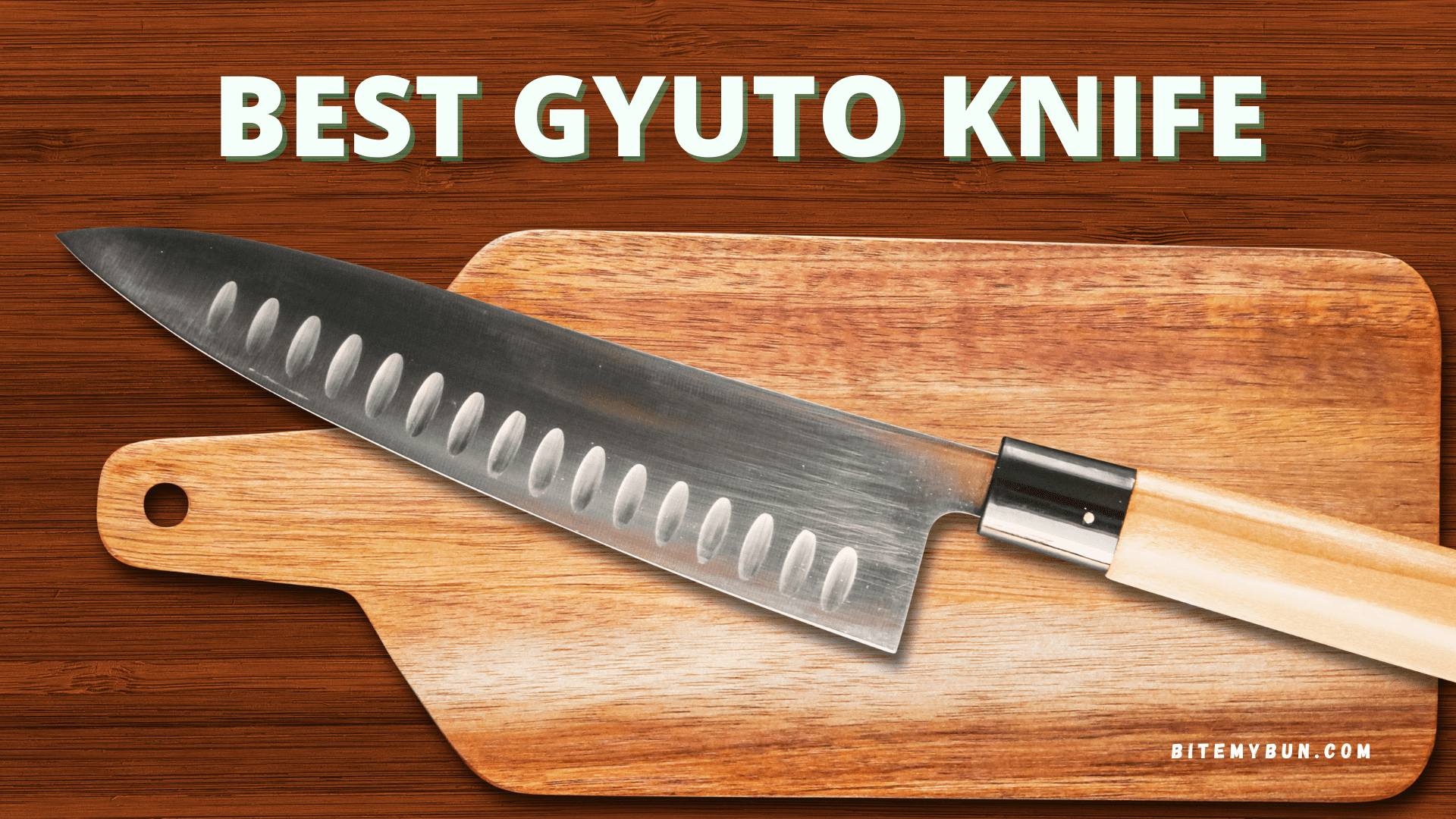
If you’ve watched Japanese chefs cutting thin strips of beef for yakiniku, or seen how fast they chop up peppers and onions for a noodle stir fry, chances are you’ve seen the gyuto in action.
Here are the best knives and you can read full reviews below:
Best overall gyuto knife
The best part about this knife is the sharp hammered finish blade. it holds its edge very well and stays sharp even after lots of cooking. Plus, the blade is resistant to wear and doesn’t chip easily.
Best mid-range gyuto knife
Forged VG-MAX carbon steel with a composition of added tungsten, cobalt and chromium to prevent corrosion and rust.
Best budget gyuto knife
Within this low price range, there are many bad knockoff knives to stay clear of. It’s surprisingly good because it has strong alloy steel blade with a hardness of 60 on the Rockwell scale.
Best smooth finish gyuto for beginners
Surprisingly, for its price, this knife has a hygienic smooth pakkawood handle and a full tang construction. The elements feel more expensive than they are.
Best gyuto knife with sheath
The reason why chefs really like this knife is that the blade has the best edge retention and doesn’t need honing as frequently as other knives.
Best gyuto knife for left-handed users
This knife is made in Seki, Japan which is well-known for its highly trained craftsmen. You can expect great quality for the price and a knife that will last for many years to come.
Also read my guide on how to properly store your Japanese knives so they stay sharp

Check out our new cookbook
Bitemybun's family recipes with complete meal planner and recipe guide.
Try it out for free with Kindle Unlimited:
Read for freeIn this post we'll cover:
Gyuto knife buyer’s guide
Buying a knife requires knowing what to look for. There are so many bad Japanese chef’s knife knockoffs that do a bad job of cutting food.
So, you’re probably asking, ‘How do I choose a Gyuto knife?’ and ‘how do I tell a good knife from a bad one?’
Authentic Japanese knives are expensive, but they last for many years, and their quality stands out from the rest.
This buying guide is here to inform you what to look for:
Blade length
The length of the knife’s blade is important because having a longer blade can make it harder to use.
If you’re a regular home cook and familiar with Japanese knives, you should have no problems handling the gyuto.
Most gyuto knives have a blade length of approximately 8-9 inches which is the traditional length of chef’s knife blades. It comes down to personal preference and the blade length you feel comfortable using in your kitchen.
Some gyuto knives have a 10-12 inch blade length, and some are shorter and less versatile.
I recommend getting the average 8-inch chef’s knife because it’s easy to use and all-purpose.
However, if you find yourself stuck between an 8.2-inch knife and a 9-inch, just know it doesn’t make a huge difference. It’s the beveling and sharpness that matters more.
Japanese knives are designed to be wieldy, even if they are longer. Generally, made-in-Japan cutlery is easy to use and gives great precision and outstanding cutting capabilities.
Blade material
Most gyuto knives are made of steel, usually a strong VG-10 or carbon stainless steel.
The carbon steel blade must be hand-washed and dried completely to prevent rust.
Consider the Rockwell scale hardness rating of the knife. The higher the number, the harder the blade is.
A hard blade can become brittle and prone to cracks and chips, but it’s the best overall blade type for a gyuto knife.
The high-quality steel blades are sure to last for many years.
Learn about the different types of steel (aogami vs shirogami) used for forging Japanese knives
Bevel
Some traditional gyutos have a single bevel blade, which cuts on a single edge.
This type of knife has better edge retention and is sharper. Therefore, it’s the top choice of Japanese chefs who need to make precise, long, and uninterrupted cuts.
The double bevel blade means it’s sharp on both sides. This type of blade is easier to use, especially for Westerners.
With this blade, you can slice, peel and make all kinds of cuts that don’t require intricate knife work.
Because most Japanese knives have a single bevel blade, left-handed chefs need special left-handed knives
Tang
The knife’s blade can be full tang or partial tang, which can make a difference in how you use it and how long it will last.
The full tang blade is generally more durable in the long term. It is more of a heavy-duty knife than a half-tang. That’s because you can exert more pressure and leverage, and it doesn’t break.
Compared to the partial/half tang, the full tang blade extends through the handle and doesn’t end inside.
Handle
Traditional Japanese knives have an octagonal-shaped wooden handle. These days, premium high-quality knives also have these characteristics.
Popular and renowned Japanese manufacturers such as Shun made genuine wood composite handles which add a pleasant appeal. These are comfortable and ergonomic but not as practical as synthetic materials.
A synthetic or resin handle is more hygienic and can protect from water damage.
The disadvantage of a full synthetic handle is that it looks cheap and feels less sturdy. However, a western-style handle is easy to hold and maneuver compared to the octagonal wood ones.
Another thing to consider is that the wood handle is known as a “wa handle,” and it is very lightweight, but the knife has a heavy blade which makes it harder to balance and makes cutting more difficult.
If the knife has a “yo handle,” it means it’s designed in a Western style and is generally heavier and thus well balanced.
Finish
Don’t forget to consider the blade’s finish. Hammered and Damascus finishes are the most common.
If the gyuto has a smooth finish, it is usually a cheaper knife and not made using traditional Japanese methods. But a smooth finish is easier to sharpen at home using a traditional whetstone.
The hammered finish looks very nice, and it just means that the steel has small ridges or pockets.
These prevent the food bits from sticking to the blade’s edge, and you don’t need to stop cutting to remove stuck-on food.
A Damascus finish is also aesthetically pleasing.
This finish is extremely durable because the blade is made by folding and layering the steel over and over to make a wave pattern. It also prevents food from sticking to the blade.
Best 6 gyuto chef’s knives reviewed
Here are the best choices when you’re shopping for a good product.
Yoshihiro VG10 16 Layer Hammered Damascus
- Full tang balanced design
- Sharp hammered Damascus finish
- Very pricy
- Non-traditional handle
- blade material: alloy steel
- bevel: double
- tang: full-tang
- handle material: mahogany wood
- finish: hammered Damascus
Have you ever started cooking your favorite Japanese recipes only to switch between knives because the vegetable knife can’t cut through tough beef cuts?
A sharp gyuto knife is a solution to this problem. This Yoshihiro Japanese knife is one of the best gyuto knives on the market because of its durable blade and beautiful wooden handle.
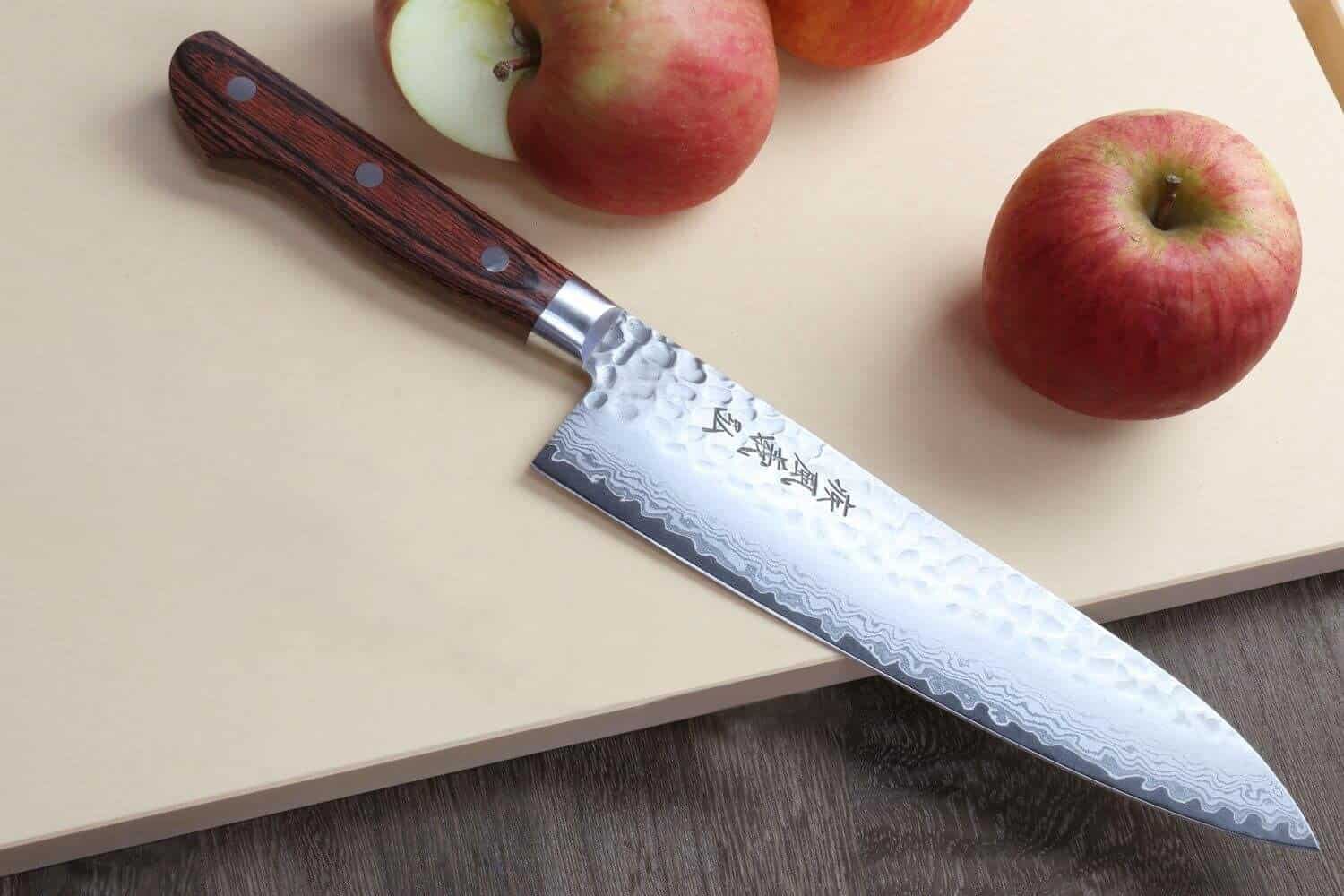
It’s best for those who want quality, versatility, and a razor-sharp edge. It’s great for precise cuts but also bigger, thicker cuts.
Therefore you can prep for yakiniku (Japanese BBQ) or make katsu curry with this one knife.
The beautiful Damascus hammered finish blade doesn’t allow food bits to stick to the blade’s edges.
Therefore, each cut is clean and fast, and you don’t need to stop midway through chopping.
The best part about this knife is the sharp hammered finish blade – it holds its edge very well and stays sharp even after lots of cooking. Plus, the blade is resistant to wear and doesn’t chip easily.
At 8 inches, the blade is the perfect length because it’s easier to maneuver and use, even for inexperienced home cooks.
If you make meals from scratch you can use the knife to cut almost all the ingredients safely because the knife is well-balanced.
A full tang design makes the knife balanced and more durable, but some users noticed small porous areas where the handle ends, and small food bits can get stuck there.
That’s one disadvantage to think about, considering it’s a pricy product.
The handle is made of mahogany wood but it’s a classic Western-style handle, not octagonal. That’s why it made the list as the best overall because everyone can use it.
It is easy to clean by hand washing and the wood ensures the knife doesn’t slip through your fingers.
Overall, you can’t go wrong with this Yoshihiro Gyuto VG10 knife because it’s known for its outstanding quality.
Shun Classic 8” Chef’s Knife with VG-MAX Cutting Core
- Durable carbon steel blade
- Great value for money
- Water and bacteria resistant handle
- Requires good care, corrosion prone
- blade length: 8-inch
- blade material: carbon steel
- bevel: double
- tang: full-tang
- handle material: pakkawood
- finish: hammered Damascus
If you want one step down from Yoshihiro, Shun is one of the top Japanese knife brands with a long history of excellent craftsmanship.
It’s hard to beat the Shun 8″ gyuto knife because it has all the features you need in a knife.
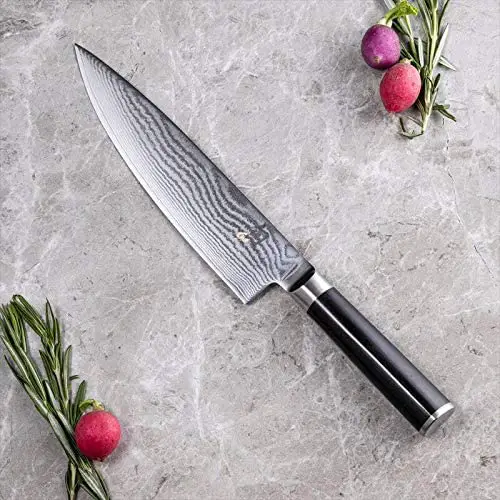
This knife has one of the best blades. It is forged of VG-MAX carbon steel with a composition of added tungsten for better edge retention.
It also contains more cobalt and chromium to prevent against corrosion and rust. In addition the blade has Damascus-style cladding and to prevent any food scraps from sticking to the blade as you chop.
When it comes to durability and strength this is knife offers excellent value for the price.
Compared to the Yoshihiro knife, there are many similarities so far but the handle is the biggest difference. This Shun knife has a sturdy PakkaWod handle infused with resin.
Therefore, the handle is smooth and shiny but also water-resistant, strong, and hygienic because the bacteria don’t stick to the surface. It has a Japanese style ‘D’ handle so it takes a bit of getting used to.
Most lefties have no issues using this knife but unfortunately, Shun doesn’t make a leftie version of this knife anymore.
The one drawback to this carbon steel blade is that it tends to rust and chip if you don’t dry it off immediately. People forget to wipe the knife completely dry and then end up with signs of corrosion.
To keep the knife in pristine condition it’s best to hone it weekly. This ensures sharpness and you won’t struggle to make any type of cut while cooking.
If you want the best and smoothest cutting experience you can rest assured this Shun knife cuts through food like butter. You don’t end with rough or interrupted cuts and it’s far superior to any of the budget knives.
Overall, it’s a durable and versatile chef’s knife and can also be bought in a selection of various sizes according to your requirements.
Yoshihiro vs Shun
These two brands are always competing with each other but they are both excellent reputable Japanese knife manufacturing brands.
Although these knives are fairly similar the handle is where they differ. The Yoshihiro has a traditional wood handle and an ergonomic design. It’s very well-balanced and makes the most precise cuts and slices.
The Shun knife has a pakkawood knife which many people prefer because it’s more hygienic and lightweight.
Overall, the Yoshihiro knife has a very strong blade and it works as a good cutter no matter what you’re cutting through. The Shun is more sensitive and prone to chipping.
That’s why I recommend the Shun for professional chefs or those looking for very particular Japanese gyutos. Yoshihiro’s gyuto is suitable for use by people of all skill levels in the kitchen.
Findking Dynasty Series 8 Inch Chef Knife
- Granton dimpled surface
- Budget but still sharp
- Dulls fast so you need to sharpen it often
- Prone to rust
- blade length: 8-inch
- blade material: steel
- bevel: single
- tang: full tang
- handle material: rosewood
- finish: hammered
Are you an occasional home cook looking for an effective knife that doesn’t break the bank?
It’s hard to find an affordable knife with as many positive reviews as the Findking 8 inch gyuto. It looks just like the traditional Japanese gyuto with a beautiful hammered finish and an octagonal wooden handle.
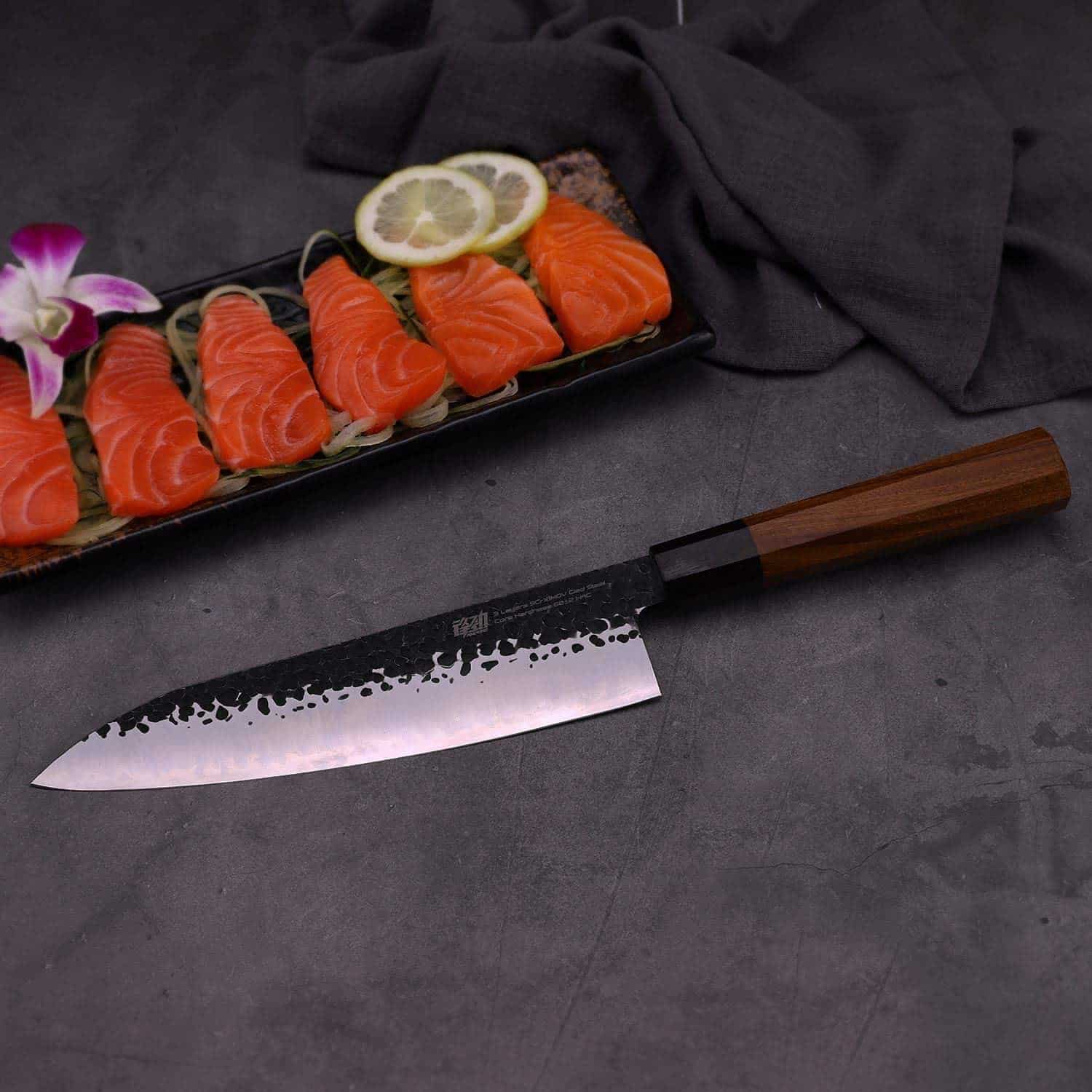
This is a great knife for beginners as well as people who like to cook and are looking to try a Japanese chef knife.
Within this low price range, there are many bad knockoff knives to stay clear of. The Findking is surprisingly good because it has strong alloy steel blade with a hardness of 60 on the Rockwell scale.
This means that it has great edge retention and stays super sharp. Users are amazed by how well-built this gyuto is. It compares to $100+ knives because it’s made with many steel layers.
The Granton (dimpled) surface makes it simple to cut all kinds of foods. The veggie scraps and small pieces don’t stay stuck to the knife.
This blade is also great for precision cutting – once you try slicing vegetables you realize they look like they’ve been machine cut!
If you struggle to balance Japanese knives this one is easy to use because it’s lightweight and well-balanced.
The only thing you need to worry about is that it does get blunt and you need to get your own whetstone to sharpen it.
Also, you can notice some rust after a few months of use but be sure to dry it and keep it in a knife block or on a magnetic knife strip.
The great blade, ergonomic wooden handle, and edge retention make this cheap knife a must-have addition to your collection.
Imarku Japanese Chef Knife
- Balanced full-tang construction
- Hygenic pakkawood handle
- On the heavy side
- Dulls quickly
- blade length: 8-inch
- blade material: high carbon stainless steel
- bevel: double
- tang: full tang
- handle material: pakkawood
- finish: smooth
Japanese gyuto knives can be intimidating, especially for people who aren’t used to them.
But, this Western Imarku knife imitates a Japanese gyuto but still has German design elements such as a double bevel, heavier weight, and a smooth finish.
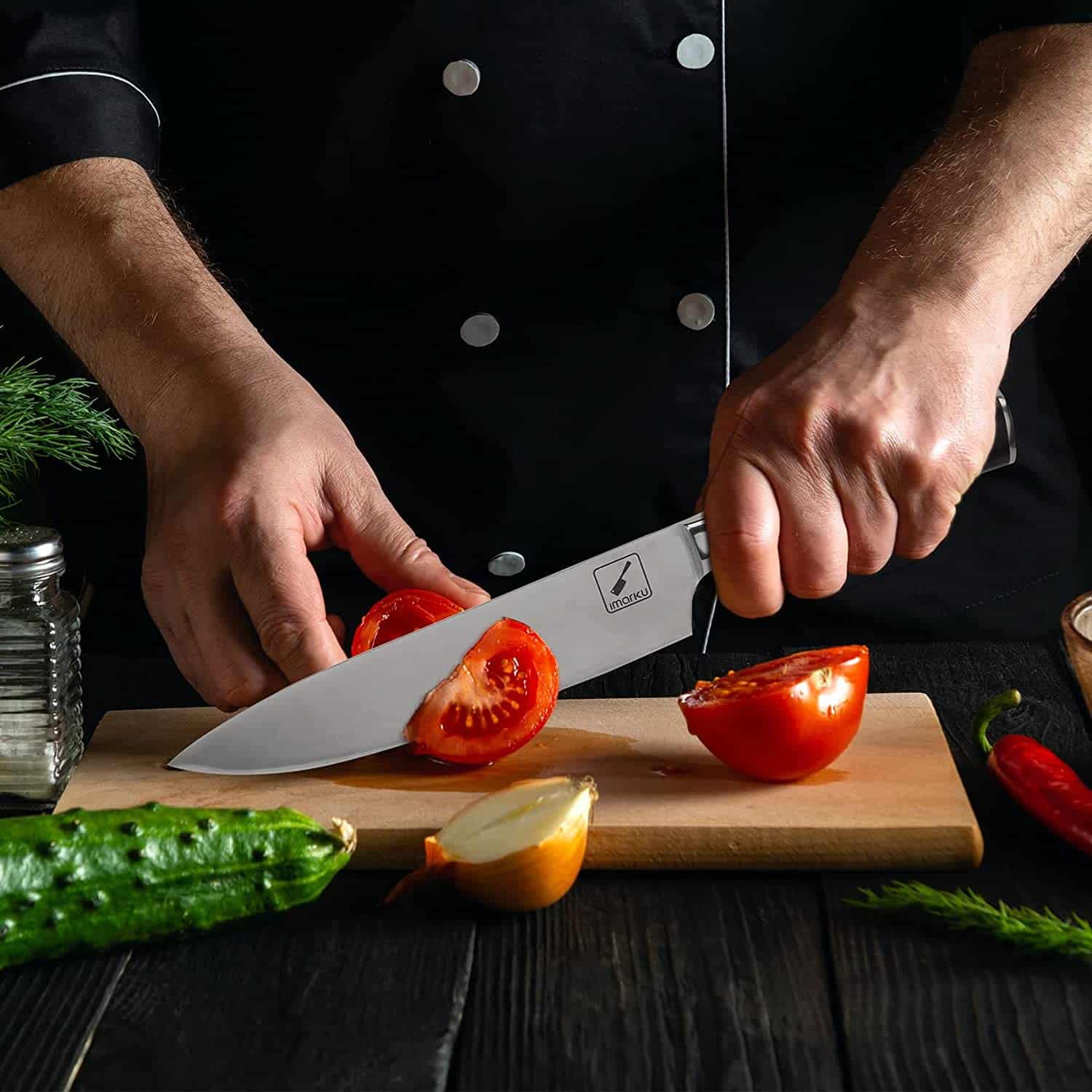
After all, the knife is made in Germany and sort of imitates the Japanese gyuto.
Using this Imarku knife is very similar to using a regular stainless steel French chef knife. However, what sets it apart is the blade material.
This knife has a strong, sharp blade made of high carbon stainless steel.
A Japanese chef might not be impressed with this knife but the average home cook can use it for all-purpose cutting and slicing kitchen tasks.
This knife can handle cutting parsnip, cutting up chicken breast, and even peeling cucumbers.
The Imarku knives are usually compared to Zelite but the Imarku is cheaper and performs just as well so there’s no need to spend more.
Surprisingly, for its price, this knife has a hygienic smooth pakkawood handle and a full tang construction. The elements feel more expensive than they are.
The knife is pretty well balanced but heavier than an authentic Japanese gyuto like the Shun, for example.
When it comes to edge retention, it’s pretty good but goes dull after a few uses so it needs lots of sharpening.
Also, it is prone to rusting easily so you need to pay special attention to the cleaning instructions and avoid the dishwasher.
If I had to use one word to describe the overall appearance and feel of this knife I’d say it looks professional even though it’s more of a budget knife.
I recommend it for all skill levels but a beginner will find it super handy and easy to use.
FindKing Dynasty vs Imarku
Both of these affordable knives are great options for beginners or those who are just getting the hang of Japanese knife skills.
These knives are very different from each other. First, the Findking has a real rosewood handle whereas the imarku has a pakkawood handle.
It depends on what you prefer but the rosewood handle is octagonally shaped so it might be harder and less comfortable to hold if you aren’t used to this shape.
The imarku knife really resembles any Western chef’s knife. Even the handle is slightly heavier and ergonomic so it’s comfy to hold for extended periods.
Now, I also want to talk about the dynasty knife’s hammered finish. It’s such a useful feature when you’re cutting food very quickly because you don’t have to pause.
However, many people don’t really mind the smooth finish because it’s easier to clean.
Both knives are good options just be aware the Findking is a better copy of a real Japanese gyuto.
Yoshihiro VG-10 46 Layers Hammered Damascus
- 46 layers of durable VG-10 carbon steel
- Traditional handle
- Small handle is not for everyone
- blade length: 8.25-inch
- blade material: carbon stainless steel
- bevel: double
- tang: half tang
- handle material: ambrosia wood
- finish: Damascus hammered
If the first Yoshihiro knife wasn’t perfect for you, the 46 layer hammered steel blade is sure to please. It also comes with a traditional wooden knife sheath, called a saya.
This Yoshihiro authentic knife is best for professional chefs who are cooking all day at the restaurant.
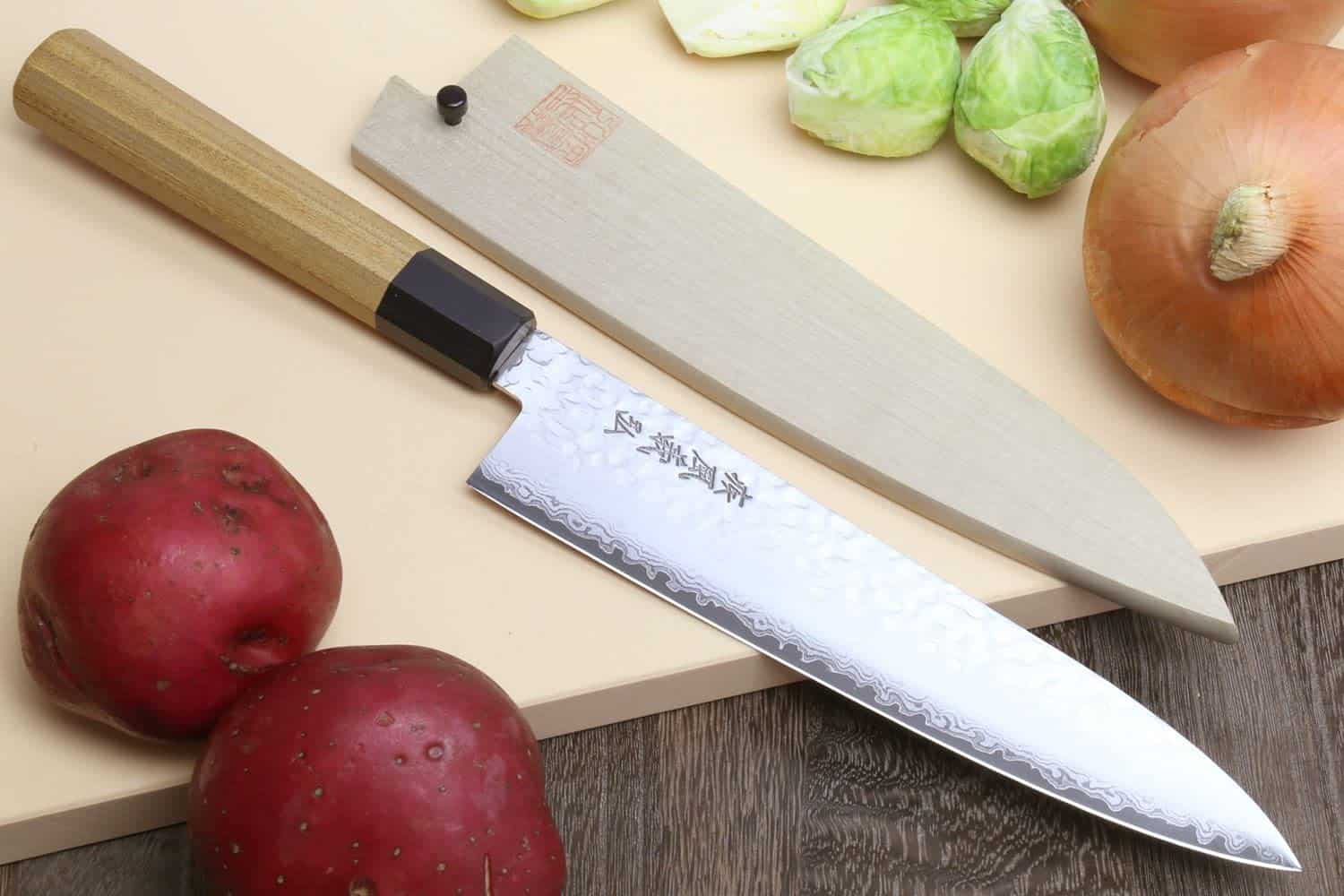
Although home cooks can use it, it is expensive, and its design requires some practice to use it properly.
The blade is made of 46 layers of carbon steel, so it’s sturdy and strong. However, you need to know your Japanese knife skills to prevent damaging the blade as it can chip easily.
The reason why chefs really like this knife is that the blade has the best edge retention and doesn’t need honing as frequently as other knives.
In terms of design, this Yoshihiro is different from the first I reviewed because it has an ambrosia wood handle. It is a premium material and also it has an octagonal shape just like the old Japanese gyutos.
When you look at the knife from an aesthetic viewpoint you’ll notice that the blade is almost mirror-polished underneath the Damascus (tsuchime finish).
As well, you can see how sharp the edge is – it will slice through thin food strips with ease.
Even the handle is extremely smooth and finely sanded. The spine and heel are smooth which indicates excellent craftsmanship.
One minor issue is that the handle is designed for smaller hands. If your hands are quite large you’ll have a harder time wrapping all your fingers around.
But overall, this is an excellent gyuto, well suited for busy kitchens with a strong steel blade that can handle cutting most foods.
Enso Chef’s Knife
- Balanced full-tang design
- Crack-resistant micarta imitation wood handle
- A lot of the price went into the handle and balance and less into the blade
- blade length: 8 inches
- blade material: stainless steel
- bevel: double
- tang: full tang
- handle material: micarta
- finish: Damascus hammered
Sure, there are plenty of good knives for the right-handed cook but what about left-handed home cooks and chefs? The Enso Japanese gyuto is designed as a universal all-purpose kitchen knife.
Luckily double bevel chef knives can be used by both lefties and righties. But not all knives are built the same way.
Fortunately, it is suitable for left-handed users who say it’s very easy to maneuver and use.
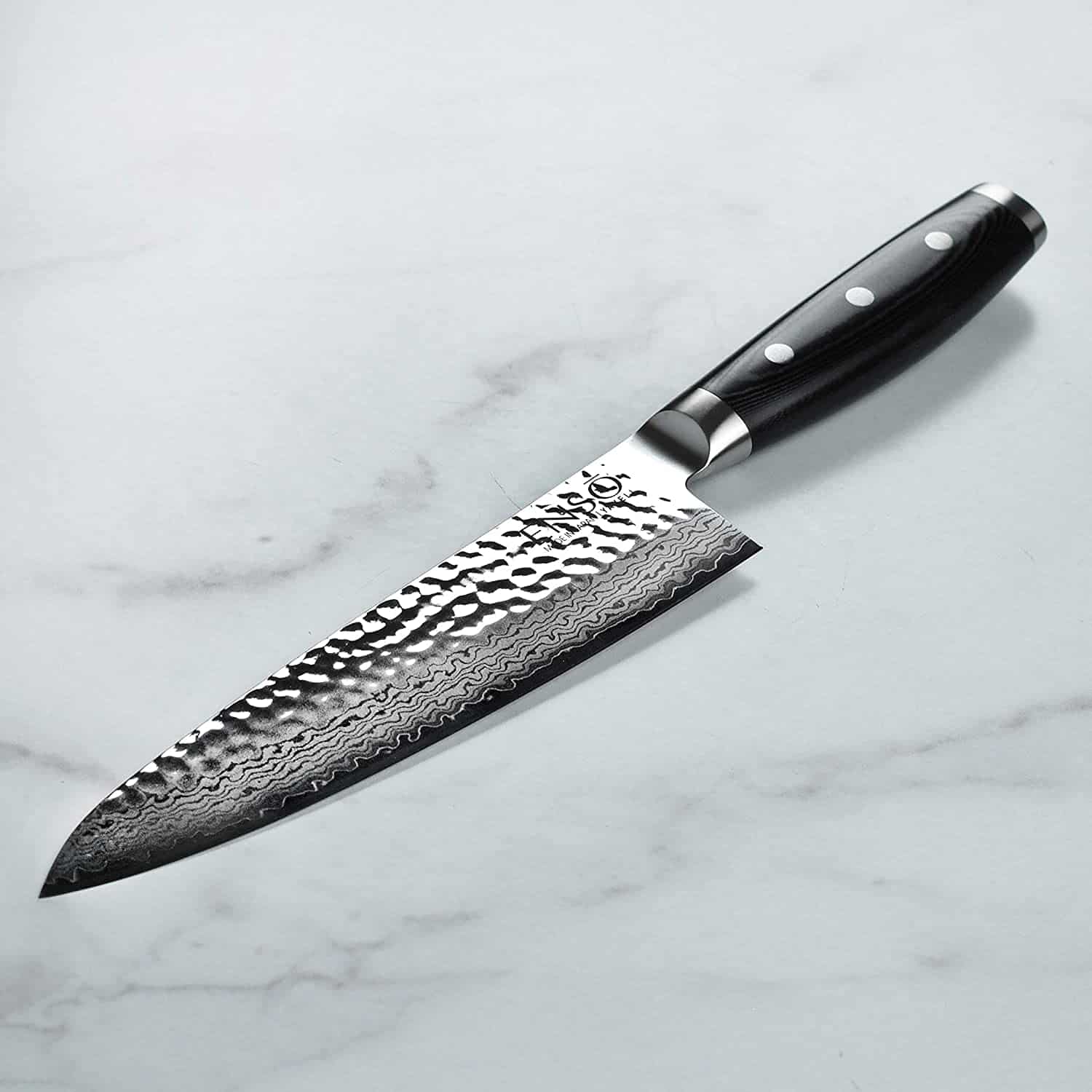
This knife is made in Seki, Japan which is well-known for its highly trained craftsmen. You can expect great quality for the price and a knife that will last for many years to come.
In fact, the knife is very similar to the Yaxell Zen (made by the same company). The build and craftsmanship set this knife apart from competitors like Katsu and Zelite which aren’t as durable for the long term.
Not only is the knife excellent for cutting through meat, fruit, and vegetables, but this gyuto is best for fine mincing garlic, herbs, and spices too.
Have you ever had a knife with a bad handle that cracks? Well, many knives with wood handles tend to crack over time.
To solve this issue, Enso has designed a micarta imitation wood handle that is crack-resistant.
One thing to note is that this blade is hard to sharpen! However, once sharpened it can hold its edge for about 6 months in a restaurant setting – how’s that for amazing sharpness?
Compared to Wusthof and Miyabi, this Enso knife has a better balance so it’s comfier to use for extended periods of chopping and cutting food.
Professional chefs like to use this knife to fillet fish and prep Wagyu beef for intricate dishes and yakiniku.
Yoshihiro vs Enso
These two gyuto knives are comparable in terms of design and performance but if you are a strong leftie who struggles with the usual double bevel knife, choose the Enso.
Left-handed users are impressed by how comfy and well-balanced that knife is so it makes cutting so much easier and faster.
Next, you should compare the handles. The Yoshihiro has an Eastern wooden handle with octagonal form. This is a good handle but it’s prone to bacteria build-up if not cleaned minutely.
The Enso knife has an imitation wood handle which is better because it doesn’t cause mold build-up. Users also say it’s comfortable to hold and doesn’t cause finger cramps.
FAQ
What is the best Japanese knife brand?
It’s hard to choose just one best knife brand.
However, there are a few Japanese knife brands to look out for because they make the best quality products:
- Shun
- Yoshihiro
- Miyabi
- Sakai
- Shibata
- Tojiro
These brands are available in North America.
Are Gyuto knives full tang?
Traditional gyuto knives are half tang but most these days have a full tang because it makes them more durable and customers seem to really love their full tang knives.
Takeaway
If you’re looking for a great alternative to your Western stainless steel chef knife, you can’t go wrong with the Japanese gyuto.
Yoshihiro and Shun are two quality brands that are worth the investment. The Yoshihiro provides amazing sharpness and will reduce your cutting and prep work significantly because it can cut and chop most foods.
Therefore, you can say goodbye to those awful dull kitchen knives you have lying around the kitchen. The gyuto offers precision and safety so you can develop your knife skills.
Another great all-rounder that’s also perfect for cutting veggies is the Santoku knife that I have reviewed here
Check out our new cookbook
Bitemybun's family recipes with complete meal planner and recipe guide.
Try it out for free with Kindle Unlimited:
Read for freeJoost Nusselder, the founder of Bite My Bun is a content marketer, dad and loves trying out new food with Japanese food at the heart of his passion, and together with his team he's been creating in-depth blog articles since 2016 to help loyal readers with recipes and cooking tips.

